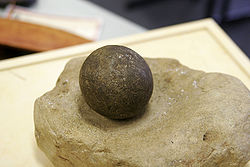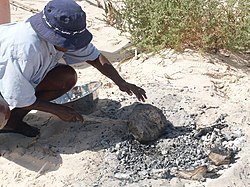Difference between revisions of "AY Honors/Aboriginal Lore/Answer Key"
| (2 intermediate revisions by the same user not shown) | |||
| Line 1: | Line 1: | ||
| − | + | [[Image:Aboriginal grinding stones.jpg|thumb|250px|Aboriginal [[millstone]] - vital in making flour or pastes for bread. Some Aboriginal groups call it "mother and child".]]'''Bush bread''', or '''seedcakes''', refers to the [[bread]] made by [[Australian Aborigines]] for many thousands of years. The bread was high in [[protein]] and [[carbohydrate]], and helped form part of a balanced traditional [[diet]]. | |
| − | + | With the arrival of Europeans and pre-[[mill]]ed white [[flour]], this bread-making process all but disappeared (women were still recorded to be making seedcakes in [[Central Australia]] in the 1970s). The tradition of cooking bread in hot [[coals]] continues today. | |
| − | + | Bread-making was a woman's task. It was generally carried out by several women at once, due to its [[labour-intensive]] nature. It involved collecting seasonal [[grain]]s, [[legume]]s, [[root]]s or [[Nut (fruit)|nut]]s, and preparing these into [[flour]] and then [[dough]], or directly into a dough. | |
| − | + | ===Bread-making from seeds=== | |
| + | ====Collecting the seed==== | ||
| + | [[Image:Damper (food).jpg|thumb|right|250px|[[Damper (food)|Damper]] is cooked in hot coals in the way traditional Aboriginal bread has been for eons.]]Seeds varied depending on the time of year and the area in Australia that the people lived. In [[Central Australia]], [[native millet]] (''Panicum decompositum'') and [[Triodia (plant genus)|spinifex]] were commonly used. [[Wattleseed]] could also be used in the flour mix. | ||
| − | + | Women harvested the fully ripe, dry seeds of the plant by beating the grass (or pod-laden trees with sticks in the case of wattleseed) to dislodge the seeds. Some species were eaten at the green stage and, when ground, would produce a juice at the side of the millstone, which was drunk directly. | |
| + | In the [[Kimberley region of Western Australia]], women observed that, after the [[dry season]], many seeds would be gathered around the opening of [[ant]]s' nests. The ants had effectively collected and [[husk]]ed the seed for them, and they were able to collect this seed, making their job a lot easier. After allowing the grain to dry, they could begin to prepare the flour. | ||
| − | ==''' | + | ====Some other seeds==== |
| + | Pigweed (''[[Portulaca oleracea]]''), Prickly wattle (''[[Acacia victoriae]]''), Mulga (''[[Acacia aneura]]''), Dead finish seed (''[[Acacia tetragonophylla]]''), Bush bean (''[[Rhyncharrhena linearis]]''). | ||
| − | [[ | + | ====Making the flour==== |
| + | After the grain was collected, it needed to be [[winnowing|winnow]]ed, which was done using the [[coolamon (vessel)|coolamon]], the multi-purpose carrying vessel. Sometimes it needed to be winnowed several times. | ||
| − | + | Once the grain was winnowed, it was ground using a [[millstone]], to create [[flour]]. Millstones have been discovered which have proven to be as old as 50,000 years. The flour was then mixed with water to make a [[dough]] and placed in hot ashes for baking. The results could be small buns, today referred to as [[johnny cake]]s, or a large loaf, known today as [[damper (food)|damper]]. Damper appears to be a mix of this traditional style of bread-making and European-style bread-making. | |
| − | + | The dough could also be eaten raw. Cooking was a good way to prepare the bread if the group was about to travel for some time. | |
| − | + | ===Bread-making from other plant products=== | |
| + | Bread could also be made from [[root]]s and [[corm]]s of plants. In the [[Top End]] of Australia, people such as the [[Yolngu]] used the [[lotus root]] and wild [[taro]]. These were ground, then mixed to a paste to make bread. | ||
| − | + | [[Water lily]] seed bread was also popular in the [[Top End]]. The two species of water lily used were ''Nelumbo nucifera'' and ''Nymphaea macrosperma''. During the early part of the [[dry season]], water lilies were an important part of the diet, with seed pods eaten raw or ground into paste. | |
| − | + | Women had expert knowledge of how to "de-toxify" certain plant foods. The [[seed]]s of the [[cycad]] palm, ''Cycas media'', are highly carcenogenic when raw and require elaborate treatment includuing shelling, crushing, leaching in running water for up to five days, then cooking. After this they are made into small loaves, which can keep for a number of weeks. | |
| − | + | In [[Queensland]], the people of the [[Tamborine National Park|Mount Tamborine]] area used the [[Bunya Pine]] cone ([[bunya nut]]), endemic to the area, to make bread in this way. | |
| − | |||
| − | |||
| − | |||
| − | |||
| − | |||
| − | |||
| − | |||
| − | |||
| − | |||
| − | |||
| − | |||
| − | |||
| − | |||
| − | |||
| − | |||
| − | |||
| − | |||
| − | |||
| − | |||
| − | |||
| − | |||
| − | |||
| − | |||
| − | |||
| − | |||
| − | |||
| − | |||
| − | |||
| − | |||
| − | |||
| − | |||
| − | |||
| − | |||
| − | |||
| − | |||
| − | |||
| − | |||
| − | |||
| − | |||
| − | |||
| − | |||
| − | |||
| − | |||
==References== | ==References== | ||
| − | * | + | *[http://katherineartgallery.com.au/index.php?page=Rachel_Rennie Bush Bread artwork] |
| − | * | + | *[http://www.japingka.com.au/exhibitionView.cfm?exhibitionID=2 Grass seed artwork] |
| − | * | + | *[http://k6.boardofstudies.nsw.edu.au/linkages/IntegratedUnits/aboriginal/tech_learn02.html Aboriginal Technology] |
| − | * | + | *[http://www.sydney-australia.biz/history/ Australian History] |
| − | * | + | *[http://www.outbushproductions.com/astories.html Making bread from bean tree] |
| + | * Peterson, Nicholas, ''[[Donald Thomson]] in Arnhem Land'', Melbourne University Press ISBN 0522850634, pp168-9. | ||
| − | [[Category:Bushfood | + | [[Category:Australian Aboriginal culture]] |
| + | [[Category:Australian Aboriginal terms]] | ||
| + | [[Category:Bushfood]] | ||
[[Category:Australian cuisine]] | [[Category:Australian cuisine]] | ||
| − | [[Category: | + | [[Category:Breads]] |
| − | + | ||
| − | [[ | + | [[zh:澳洲土著麵包]] |
Revision as of 03:44, 25 November 2006

Bush bread, or seedcakes, refers to the bread made by Australian Aborigines for many thousands of years. The bread was high in protein and carbohydrate, and helped form part of a balanced traditional diet.
With the arrival of Europeans and pre-milled white flour, this bread-making process all but disappeared (women were still recorded to be making seedcakes in Central Australia in the 1970s). The tradition of cooking bread in hot coals continues today.
Bread-making was a woman's task. It was generally carried out by several women at once, due to its labour-intensive nature. It involved collecting seasonal grains, legumes, roots or nuts, and preparing these into flour and then dough, or directly into a dough.
Bread-making from seeds
Collecting the seed

Seeds varied depending on the time of year and the area in Australia that the people lived. In Central Australia, native millet (Panicum decompositum) and spinifex were commonly used. Wattleseed could also be used in the flour mix.
Women harvested the fully ripe, dry seeds of the plant by beating the grass (or pod-laden trees with sticks in the case of wattleseed) to dislodge the seeds. Some species were eaten at the green stage and, when ground, would produce a juice at the side of the millstone, which was drunk directly.
In the Kimberley region of Western Australia, women observed that, after the dry season, many seeds would be gathered around the opening of ants' nests. The ants had effectively collected and husked the seed for them, and they were able to collect this seed, making their job a lot easier. After allowing the grain to dry, they could begin to prepare the flour.
Some other seeds
Pigweed (Portulaca oleracea), Prickly wattle (Acacia victoriae), Mulga (Acacia aneura), Dead finish seed (Acacia tetragonophylla), Bush bean (Rhyncharrhena linearis).
Making the flour
After the grain was collected, it needed to be winnowed, which was done using the coolamon, the multi-purpose carrying vessel. Sometimes it needed to be winnowed several times.
Once the grain was winnowed, it was ground using a millstone, to create flour. Millstones have been discovered which have proven to be as old as 50,000 years. The flour was then mixed with water to make a dough and placed in hot ashes for baking. The results could be small buns, today referred to as johnny cakes, or a large loaf, known today as damper. Damper appears to be a mix of this traditional style of bread-making and European-style bread-making.
The dough could also be eaten raw. Cooking was a good way to prepare the bread if the group was about to travel for some time.
Bread-making from other plant products
Bread could also be made from roots and corms of plants. In the Top End of Australia, people such as the Yolngu used the lotus root and wild taro. These were ground, then mixed to a paste to make bread.
Water lily seed bread was also popular in the Top End. The two species of water lily used were Nelumbo nucifera and Nymphaea macrosperma. During the early part of the dry season, water lilies were an important part of the diet, with seed pods eaten raw or ground into paste.
Women had expert knowledge of how to "de-toxify" certain plant foods. The seeds of the cycad palm, Cycas media, are highly carcenogenic when raw and require elaborate treatment includuing shelling, crushing, leaching in running water for up to five days, then cooking. After this they are made into small loaves, which can keep for a number of weeks.
In Queensland, the people of the Mount Tamborine area used the Bunya Pine cone (bunya nut), endemic to the area, to make bread in this way.
References
- Bush Bread artwork
- Grass seed artwork
- Aboriginal Technology
- Australian History
- Making bread from bean tree
- Peterson, Nicholas, Donald Thomson in Arnhem Land, Melbourne University Press ISBN 0522850634, pp168-9.
